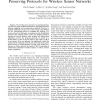Free Online Productivity Tools
i2Speak
i2Symbol
i2OCR
iTex2Img
iWeb2Print
iWeb2Shot
i2Type
iPdf2Split
iPdf2Merge
i2Bopomofo
i2Arabic
i2Style
i2Image
i2PDF
iLatex2Rtf
Sci2ools
ISCAS
2005
IEEE
2005
IEEE
Decentralized energy-conserving and coverage-preserving protocols for wireless sensor networks
Abstract— The wireless sensor network is an emerging technology that may greatly facilitate human life by providing ubiquitous sensing, computing, and communication capability. However, to maintain sufficient coverage and to achieve long system lifetime are two contradicting factors in designing the topology of a sensor network. In this paper, we propose several decentralized protocols that schedule sensors’ active and sleeping periods to prolong the network lifetime while maintain the sensing field sufficiently covered. The proposed protocols are based on a model similar to that of [8], but improve the results of [8] in several senses. First, our approach can significantly reduce the computational complexity incurred, and at the same time achieve better accuracy in determining the coverage of the sensing area. Second, we further enhance the results of [8] by proposing an optimization mechanism to further balance or reduce sensors’ energy expenditure.
| Added | 25 Jun 2010 |
| Updated | 25 Jun 2010 |
| Type | Conference |
| Year | 2005 |
| Where | ISCAS |
| Authors | Chi-Fu Huang, Li-Chu Lo, Yu-Chee Tseng, Wen-Tsuen Chen |
Comments (0)

